Apple 15-inch MacBook Pro (Late 2011) Review
by Anand Lal Shimpi on November 17, 2011 5:10 PM EST- Posted in
- Mac
- Apple
- Intel
- MacBook Pro
- Sandy Bridge
- Laptops
Display Quality
The display hasn't changed since earlier this year, although this is the first 15-inch 2011 MacBook Pro that I've tested with the standard resolution (1440 x 900), glossy panel. Aesthetically I prefer this panel (I'm the rare case that isn't bothered by gloss) and the lower resolution is easier on my eyes, but for productivity I do feel the 1680 x 1050 upgrade is worth it. If this is going to be a workhorse, and you have good eyesight, get the high-res version.
As always, Apple calibrates its panels at the factory. Note the out-of-the-box white point across the 11-inch MacBook Air, 13-inch MacBook Air and 15-inch MacBook Pro:
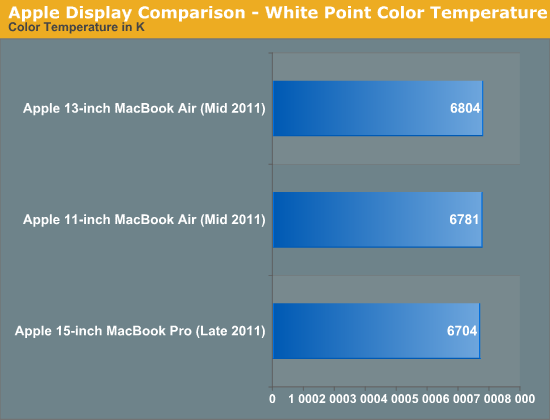
Apple wants to deliver as consistent of an experience as possible across its product line. While the Air models still don't have quite as high quality a panel as the Pro, at least there aren't any wide variations in what constitutes white on these panels.
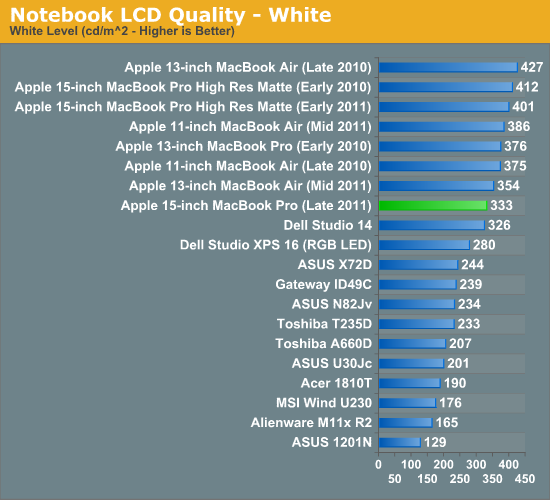
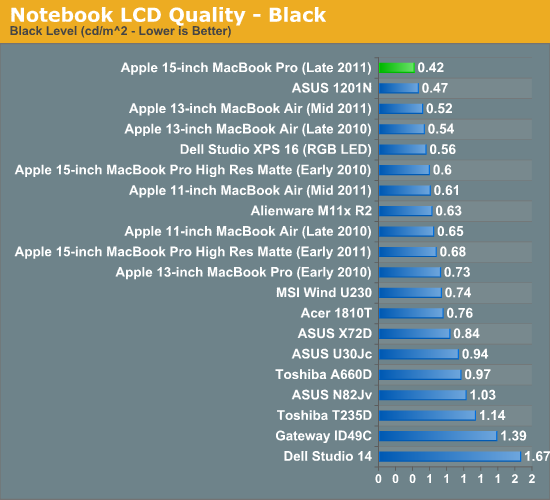
Brightness is down a bit compared to the high-res panel we looked at earlier this year, but so are black levels. The combination of the two actually results in a slightly higher contrast ratio than what we measured on the early 2011 models. In practice the panel looks just as good and seems to get just as blindingly bright as my personal 15-inch.
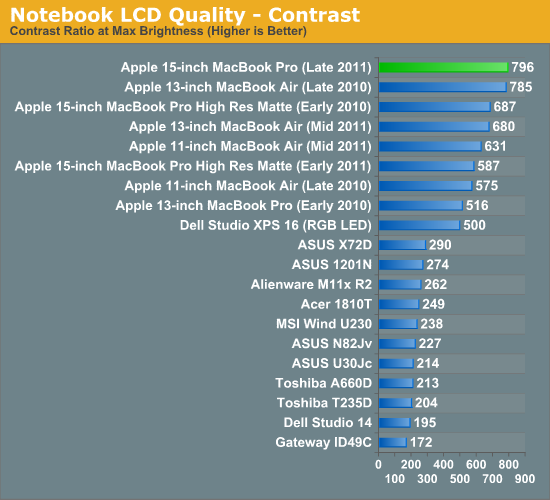
Color quality and gamut are virtually identical as well, no surprises here:
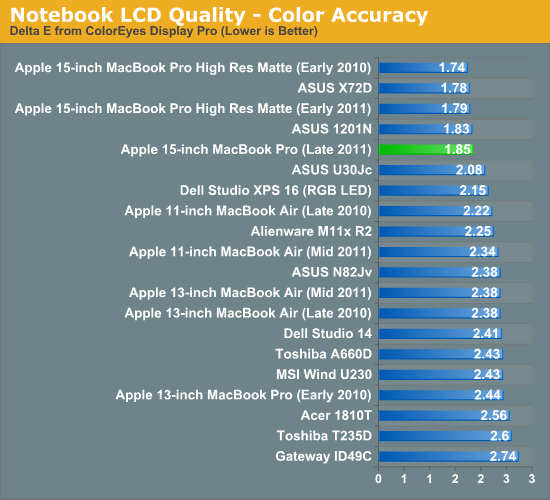

Hard Drive
The more traditional Macs (MBP, Mac Pro, iMac) continue to ship with mechanical hard drives by default, the late 2011 update is no different. My review sample came with a 5400RPM Toshiba MK5064GSXF. The drive features two 320GB platters (obviously not all in use for the 500GB capacity), and an 8MB cache.
All of my personal systems use SSDs and in testing the new MBP with a hard drive I can only say that the move back is more painful than ever. It's most noticeable when multitasking. Installing applications while browsing the web and copying files just seems to slow to a crawl compared to my SSD equipped MacBook Pro. If you're going to buy any new machine, especially if you're paying top dollar for something you expect to feel fast, you definitely need an SSD.

The good news is Apple's SSD pricing isn't horribly unreasonable, at least at the beginning. For $200 you can upgrade the 15-inch MacBook Pro to a 128GB drive (most likely a 3Gbps Samsung based SSD). It's when you look at the 256GB or larger drives that you're probably better off buying your own. You can buy a 256GB Crucial m4 for under $400 today, and a 240GB Vertex 3 will set you back around $460. Both options are cheaper (and faster) than Apple's $600 256GB upgrade. If you get the high-end 15-inch MBP model however, the upgrade prices drop by $100 - making the Apple route much more cost competitive. You don't get the same performance you would from an aftermarket drive, but with less headaches and potential for issues it's possibly a better route.
The 512GB drives are most definitely not a bargain from Apple. To equip a 15-inch MBP with a 512GB SSD, Apple wants $1200. You're much better off buying a 512GB Samsung SSD 830 for under $800 and pocketing the difference.
| Apple SSD Upgrade Pricing | |||||
| 128GB | 256GB | 512GB | |||
| 13-inch 2011 MacBook Pro | $200 | $600 | $1200 | ||
| 13-inch 2011 MacBook Pro (high end) | $100 | $500 | $1100 | ||
| 15-inch 2011 MacBook Pro | $200 | $600 | $1200 | ||
| 15-inch 2011 MacBook Pro (high end) | $100 | $500 | $1100 | ||
| 17-inch 2011 MacBook Pro | $100 | $500 | $1100 | ||
What aftermarket SSD should you buy? If you want to play it safe and hang on to TRIM support, go with Apple. Ever since I've been reviewed SSDs however I've run aftermarket SSDs in my Macs, mostly without any major issues. I can vouch for the Intel SSD 510, Samsung SSD 830 and OCZ Vertex 3. At one point or another I've used all of them in my 2011 MacBook Pro. My current setup is a Samsung 830 in the primary drive bay and an Intel SSD 510 in place of my optical drive, the combination works wonderfully.
Still Great WiFi
Apple continues to quietly focus on delivering excellent WiFi performance with the MacBook Pro. In the late 2011 models WiFi is still powered by Broadcom's BCM4331 3x3 solution. A quick test with a 3rd generation Time Capsule showed us peak transfer rates of 154Mbps, in line with what we've seen with the first generation Sandy Bridge MacBook Pro.

Despite Apple's move to Bluetooth 4.0 support on some of its other platforms, the MacBook Pro remains at 2.1 with the same BCM2070 controller.
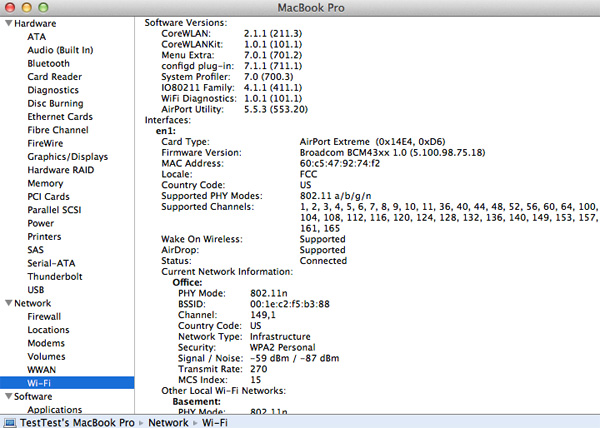


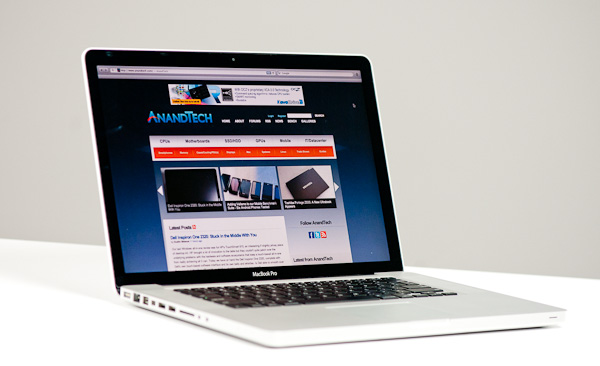








101 Comments
View All Comments
Omid.M - Monday, November 21, 2011 - link
Is 22W TDP? I thought I saw 35W or the same as current platform, at least on some chart a few months back.And wouldn't the power/heat savings of a 22W TDP be negated by going to a slimmer design, if that's the next move for the rumored model update in Summer 2012?
Anand,
Good thoughts about the optical drive not being the sole factor in making the chassis thinner.
Correction (?)
Given that there are no reasonable performing HDDs in a smaller form factor, one would assume that if and when Apple removes the optical drive from the MacBook Pro, it will also remove the hard drive.
--it will also move way from the 2.5" form factor HDDs
Right?
@moids
Omid.M - Monday, November 21, 2011 - link
What do you recommend for photo work?Quad core MBP 15 + ACD or iMac 27 (quad core) ?
@moids
KoolAidMan1 - Monday, November 21, 2011 - link
Here is a benchmark with recent machines, but unfortunately they are only video apps: http://barefeats.com/macs11_01.htmlHere are Aperture benchmarks from August, so tweaks your expectations accordingly: http://barefeats.com/aper313.html
Performance is excellent both ways, so ask yourself what your usage is. Does your powerhouse workstation need to be portable? Do you need a laptop? If so, get the MBP+TB display. Otherwise save your money and get an iMac instead, much much cheaper than the laptop+TB display.
spamcops - Tuesday, November 22, 2011 - link
I just registered because of this article suggesting Intel SSD 510 disk with this macbook pro model. Actually I was testing this disk with Macbook Pro 13' early 2011 and its horrible. There are lockups in IO intensive reads (for example spotlight indexing, lock lasting like 30s - basicaly you sea only beachball). Result are messages about corrupted filesystem in system.log. Probably its same issue with late 2011 model. EFI firmware update 2.3 didnt helped.It looks like there is issue with sata cable or something with macbook pro and all 6gbit SSD disks (not only intel).
Then I tested Intel SSD 320 model and it was fine - very good performance without problems, even if negotiated speed was only 3Gbit (SATA2).
Cheers
Daniel
MadMacMan - Thursday, November 24, 2011 - link
Are you talking about the optical drive bay or the main HDD bay? SATA III 6Gbps works just fine in the main hard drive bay and on 13" MBP's (as opposed to 15" and 17" models, both Early and Late 2011), you can even RAID 2 SATA III SSD's for sequential speeds north of 900MB/s. I'm not sure why you have the experience that you do, but that's not the case on a widespread basis. I've tried this on one Early-2011 15" MBP and two Late-2011 17" MBP's.CalaverasGrande - Tuesday, November 22, 2011 - link
still maxes at 8gb! I know that may seem like plenty of ram, but those of us using VM's can easily exploit all of the ram that is available. Not to mention that many Mac users will hang on to their Macs for 4-5 years. I am confident 16gb will be the new 4gb by then!MadMacMan - Saturday, December 10, 2011 - link
Agreed. I have 8GB in my Late-2011 MBP and I'm using it all and it's just about the perfect amount for Safari and Chrome and 40+ tabs open at the same time between the two. So it'll happen that I have Flash plug-in's running on both and Netflix uses Silverlight, and while I do realize that I could cut that in half with a little bit of discipline, I simply don't care to. I didn't buy a Quad Core i7 system to save on...anything really. I'm still peeved that the optical drive bay won't work well with my 2nd of two SATA III SSD's in RAID mode, as I had my previous Mac configured.Having said that, there are 8GB modules available from OWC for quite a steep fee, but it's technically not correct that the MacBook Pro is limited to 8GB of RAM. If you get two of those babies, you'll have a full 16GB, which I had at one time but in an iMac, so it was 4x4GB and tons cheaper, of course. With that setup, I was able to run a VM with Windows 7 in it, so dedicating 8GB to the VM and having both OS X and Windows running on all cylinders and totally stably was not a problem.
UPDATE: Wait a minute. Prices have plummeted to "only" $395 for the full 16GB! Wow! So if you have 2x4GB, you can get one 8GB chip for $200, sell the one 4GB stick to offset the cost and you'll end up with 12GB for the difference. Hmmm....lol
flomt - Saturday, December 24, 2011 - link
Does Apple ship you a product to test, knowing who you are, or do you go to a store and buy one?I have a macbook pro 13 mid 2010 and out of the box only got half the battery life you seen to have.
After visiting with Apple about my "poor" battery life, they said I was normal.
Visiting with some friends, nobody came come close to your battery times.
Why the big differences?
bob33 - Saturday, March 24, 2012 - link
So, as gradjoh mentioned, in layman's terms is the "early 2011" 2.3 GHz 4Gb RAM model better than the "late 2011" 2.4 GHz 4Gb RAM model, in terms of speed/performance, etc.?Thanks
MiddletonBanks - Tuesday, April 17, 2012 - link
If you are looking for a macbook to run memory hungry games or to do a lot of photo editing and won't be looking to carry it about everyday then the macbook pro 15 is the one for you. You can buy it here http://www.middletonbanks.com/acatalog/Apple_MacBo... for only £1,240 including VAT and delivery.